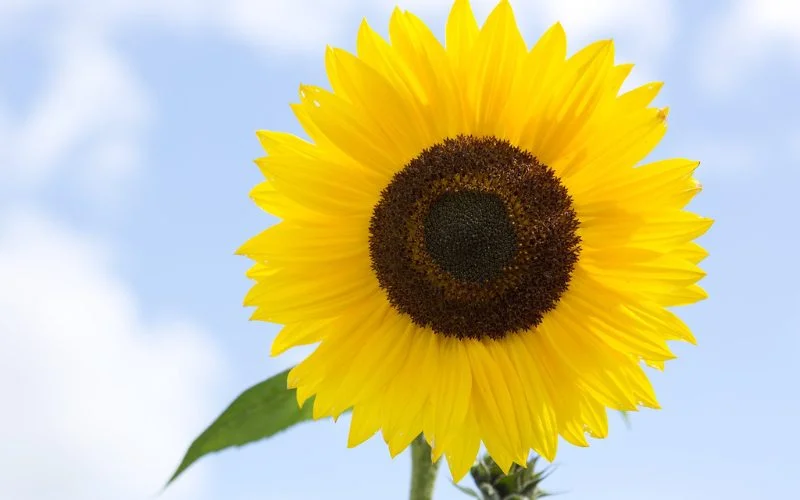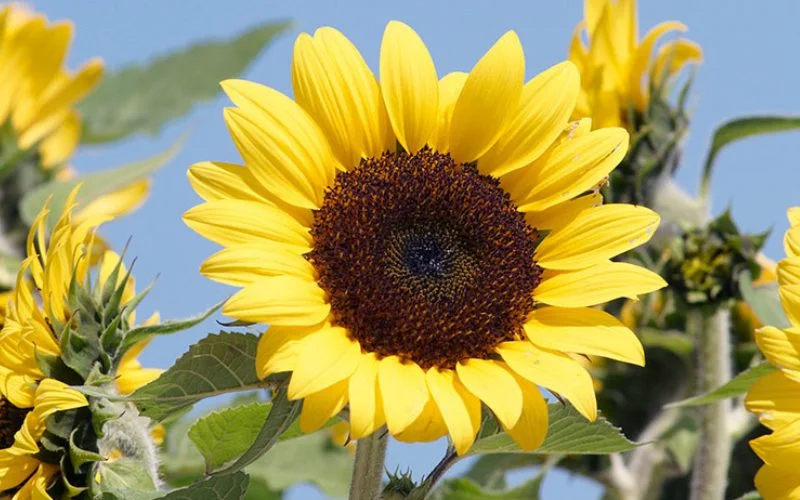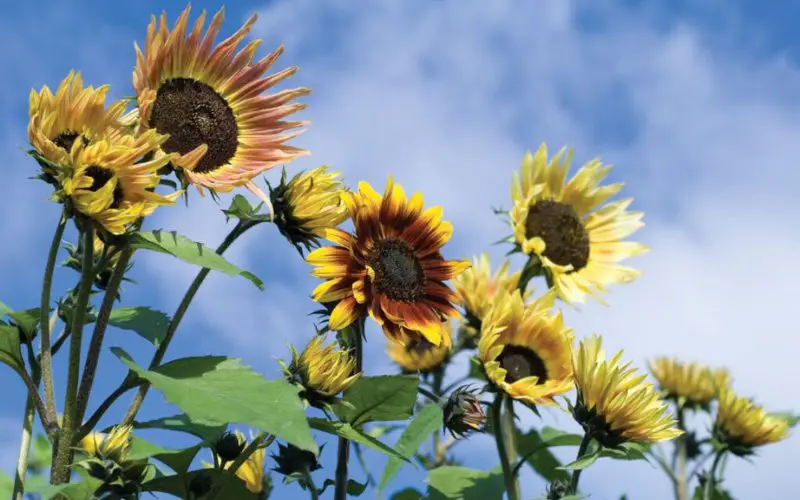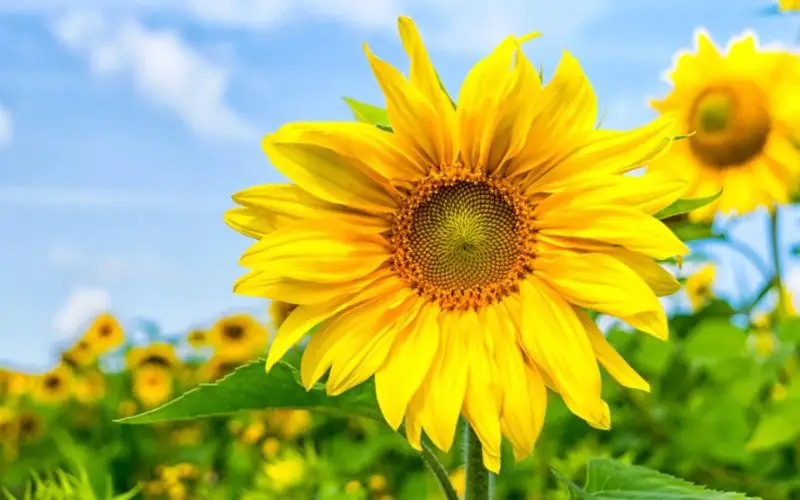The sunflower is a trendy flower that has been the theme of many artworks, gardening, and food recipes. That is because this lovely flower which is renowned for its bright and bold yellow petals can accentuate the beauty of any space you put it in,
Now, if you are thinking of growing some of them in your garden and wondering if you can plant the flower head, the answer is No, but you can get the seeds from the flower head and show them or plant the flower’s stem.
Today, we delve into the beautiful world of sunflowers and why you will love them.
About Sunflowers

The sunflower, whose botanical name is Helianthus annuus, is an annual plant with a sizeable daisy-like flower face that is primarily yellow.
There are others, however, that are red, maroon, orange, or brown. The center of the flower is brown, and when they are ripe, they have heavy heads filled with seeds.
One of the peculiar characteristics of sunflowers is the fact that they are heliotropic. That means that these plants can turn their flowers as they follow the sun’s movement as it moves across the sky from the east to the west, and then at night, it returns to face the east, only to resume this “movement” the following day.
This Heliotropic movement usually occurs during the earlier phases before the flower grows heavy with seeds.
There are wide varieties of sunflowers, and most have their distinguishing characteristic: from those with branching stems or single stems to those that manufacture ample pollen for pollinators or are pollen-free (best for bouquets).
Some are small, while others tower above the rest of the garden. There are still some that produce edible seeds.
20+ Interesting Facts About Sunflower

1. Sunflowers are native to America and cultivated in North America as early as 3000 BC.
2. The state of Kansas is the state of the sunflower.
3. Spanish conquerors exported the flowers to the rest of the world by around 1500.
4. By the 19th century, about 2 million sunflowers were planted in Russia alone.
5. In 1946, Missouri farmers began producing sunflower oil after Canada developed a seed-crushing machine.
6. In the 1970s, consumers took sunflower seed oil as a low-cholesterol alternative to animal fats.
7. Sunflowers are sun-loving plants that grow best with not less than 6 hours of sun a day.
8. On average, they can grow as tall as 16 feet, while the stem can grow as tall as 12 ft, and the diameter of the head can be as much as reaching over 12 inches in diameter.
9. Sunflower buds exhibit heliotropism, a stimuli response to the sun that causes the young blossoms to face east in the morning and follow the sun throughout the day.
10. Each Sunflower’s head is made of smaller flowers.
11. Sunflowers l can self-pollinate or take pollen transported by insects or blown by the wind.
12. The average sunflowers have between 1,000 to 1,400 florets and potential seeds.
14. Do you know that you can convert sunflower heads into scrubbing pads?
15. Ukraine is the l largest sunflower seed producer in the world, followed by Russia. At the same time, South Dakota is the most prominent producer of sunflowers in the United States, followed by North Dakota and Texas.
16. There are two main types of sunflower seeds: the white or grey, mainly used for snacks and animal food, and the Black seeds, which are 45% richer in Sunflower oil and mainly used in manufacturing.
16. There is between 38% to 50% oil in oil seed sunflowers.
17. Sunflowers are entirely edible, from the roots to the petals.
18. The tallest Sunflower was grown in Germany in 2014. It measured an impressive 30 feet and 1 inch tall.
19. Native Americans used sunflower oil to cure skin ailments.
20. Sunflower seed was used to make blue or black dye, while the petals were used to make a yellow dye.
21. Do you know that a dry sunflower head with seeds in them can be used as a feed feeder for feeding birds in winter?
22. Sunflower stems can be dried and used for winter kindling.
23. An anonymous person paid over $39 million in 1987 for Vincent van Gogh’s Sunflowers painting.
Can You Plant a Sunflower Head

No, sunflowers are mainly propagated with their seed or stem cuttings. You don’t plant the whole head because it contains lots of seeds; moreover, you need the seeds to be dry before planting them.
If you desire to get the best from your sunflower, you should plant new seeds each spring. These are the ways of planting sunflowers:
Seed Propagation Of Sunflower
If you desire to grow sunflowers from the seed, then you will need the following:
- Sunflower seed
- Soil mix
- Containers for nursery
- N:P: K fertilizers
Procedure:
1. Get a medium-sized container about 4 to 5 inches deep with drainage holes at the bottom.
2. Now, fill the container to about three-quarters of its volume with the soil mix. Press the soil and make it firm to make an even surface.
3. Now sow the seeds in the soil at a distance of 2 to 3 inches apart, then gently cover the seeds with an inch layer of the soil mix.
4. Water the seed gently to ensure it is not moved from their positions.
5. Now, place the container in a sunny spot where it can get enough sunlight. Water the seeds gently every day, and the seed will start germinating after a week.
6. They will require a fertilizers mixture made by mixing half a tablespoon of NPK 19:19:19 fertilizer mixed in 1 liter of water. Transplant the sunflowers when it is about 5 to 6 inches tall.
7. You can transfer the places to the soil or pot ( depending on where you want the plant to grow). A 10 to 12 inches big pot will accommodate one plant. If, however, you will be growing the plant directly in the soil, then you will have to space each plant 30 inches apart, especially if they are the more prominent varieties of sunflowers, but for smaller varieties, you should reduce the spacing to 20 inches.
8. Always water the plants very well so they stay water-stressed.
It would be best if you watered the plants well, especially before and after the development of flower buds, so as not to hamper the plant’s growth.
In about 60 to 65 from sowing the seeds, buds will start developing, and after 70 days, the flowers will bloom. The flower will continue to bloom for about 15 days, and within 100 to 125 days of sowing the seed, you can collect the seeds from the brown flowers.
Stem Propagation Of Sunflower
These are the steps for propagating Sunflowers using stem cuttings:
1. Look for a 4 to 6-long and healthy sunflower stem that is matured, and make a 45-degree cut below.
2. Plant the cutting in a soil mix with a good amount of compost. You can fill the cutting with cinnamon powder and honey for the cutting to root faster.
3. Don’t play e the cutting in the sun yet; keep it in the shade for about a week before moving it to full sun.
4. Water it frequently and use the same fertilizers used for seed Propagation of sunflowers. In 50 or 60 days, your sunflower will bloom.
The Varieties Of Sunflowers

There are more than 70 different varieties of sunflowers globally, and these drought-tolerant and pest-resistant plants, which are low-maintenance flowers, thrive in many climates. Here are some of the multiple common varieties of sunflower you find around:
Skyscraper Sunflowers
As the name suggests, this very tall sunflower can grow to a height of 22 to 14 feet. They have thick stalks, and their petals can be as large as 14 inches.
The Towering ‘Mammoth’
It is another enormous variety of sunflowers that can grow to 12 feet tall. They are suitable varieties for snacking on and also feeding your birds.
Sunforest Mix Sunflowers
This giant sunflower cultivar requires a lot of space for the roots to grow well. The plant grows to almost 15 feet in height.
‘Teddy Bear’
Teddy bear is a relatively small variety of sunflower that grows to just 2 to 3 feet tall. This little sunflower is ideal for small gardens and containers. They are fluffy and have a 5-inch deep gold. Blossoms.
American Giant Sunflowers
The American Giant sunflowers can grow up to 15 feet tall with faces about 1 foot wide. It has a chunky and sturdy stem that supports the heavy head of the sunflower.
Russian Mammoth Sunflowers
Bees, butterflies, birds, squirrels, and other animals love this cultivar of sunflowers because they enjoy their seeds. This flower can grow from about 9 to 12 feet tall.
Autumn Beauty
It is a unique variety of sunflowers with a branching stem that can grow to a height of 7 feet and has many 6-inch flowers in shades of yellow, bronze, and mahogany.
Conclusion
Plant sunflowers if you are looking for a flower to beautify your home. Suppose you are looking for a healthy snack to chow on, plant sunflowers. If you need feed for your birds or oil to cook with, still plant sunflowers.
Helpful Links:
- How Many Heads of Cabbage Per Plant
- What is the Best Ground Cover for Under Pine Trees?
- How Many Heads of Cauliflower Per Plant
- Do Broccoli Plants produce More Than One Head?
- How to Plant Garlic Heads
Sunflower is a plant that is useful, both aesthetically and practically. Its nutrient value is off the roof, and it is a plant that rewards you in more ways than one.
You can, however, only plant a part of the sunflower because you will be planting many seeds in a spot.
Follow us on Facebook, Instagram, and Pinterest for more updates.

